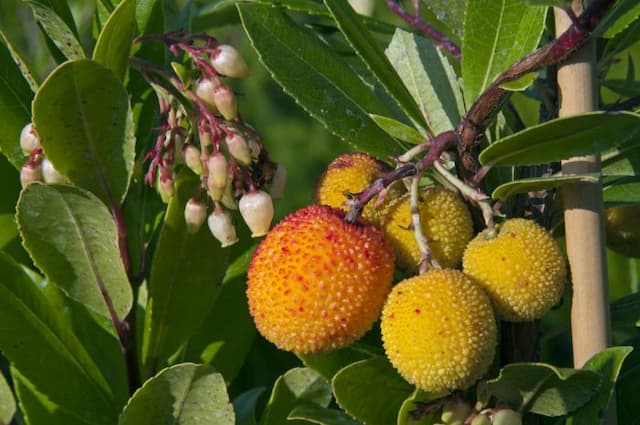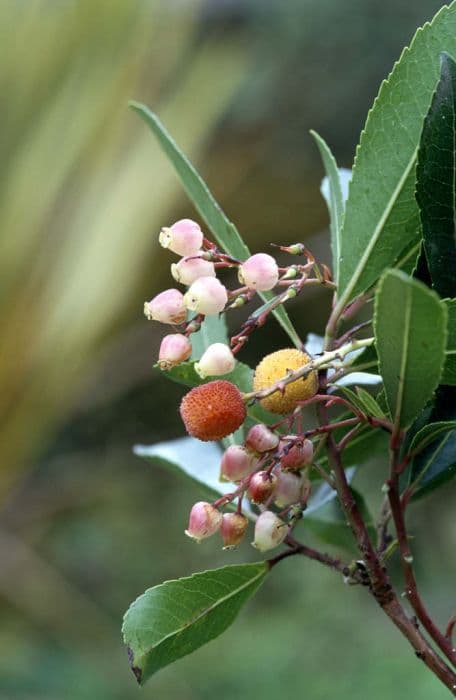Rhododendron Rhododendron 'Mrs R.s. Holford'

ABOUT
Rhododendron 'Mrs R.s. Holford' is a visually striking flowering shrub known for its vibrant and showy blooms. The flowers are typically large and bell-shaped, often appearing in clusters. They display an alluring color, usually a shade of pink, which can range from soft pastel hues to more intense tones, sometimes with subtle variations and patterns within the petals. The blooms are usually adorned with a distinctive darker blotch at the base of each petal, adding to their ornate appearance. Surrounding these blooms is an abundance of dark green, glossy leaves that provide a lush, dense foliage backdrop. The leaves are leathery to the touch and have a smooth, slightly curved surface with well-defined veining, creating a rich tapestry of green against which the flowers stand out prominently. This rhododendron typically presents a symmetrical and well-rounded shape, offering a full and robust appearance even when not in bloom. The branches are sturdy and may spread outwards, draped with leaves and flowers. The overall impression of Rhododendron 'Mrs R.s. Holford' is one of classic garden elegance, drawing the eye with its delightful floral display and maintaining interest with its year-round foliage.
About this plant
 Names
NamesFamily
Ericaceae
Synonyms
Mrs. R.S. Holford Rhododendron
Common names
Rhododendron 'Mrs R.S. Holford'
 Toxicity
ToxicityTo humans
Rhododendrons, including 'Mrs. R.S. Holford', contain grayanotoxins which can be poisonous to humans if ingested. Symptoms of rhododendron poisoning can range from mild to severe and may include vomiting, diarrhea, hypersalivation, weakness, coma, hypotension, CNS depression, cardiovascular collapse, and potentially death if a significant enough amount has been consumed.
To pets
Rhododendrons are toxic to pets, with grayanotoxins being the harmful compounds. If pets ingest any part of a rhododendron plant, they may display symptoms such as vomiting, diarrhea, drooling, weakness, tremors, seizures, or even lead to coma and death in severe cases. Immediate veterinary attention is required if a pet consumes any part of a rhododendron.
 Characteristics
CharacteristicsLife cycle
Perennials
Foliage type
Evergreen
Color of leaves
Green
Flower color
Mixed
Height
5 feet (1.5 meters)
Spread
6 feet (1.8 meters)
Plant type
Shrub
Hardiness zones
5
Native area
Asia
Benefits
 General Benefits
General Benefits- Decorative Appeal: The Rhododendron 'Mrs. R.S. Holford' offers vibrant blooms that enhance the aesthetic appeal of gardens and landscapes.
- Habitat Support: This plant provides shelter and nectar for pollinators such as bees, butterflies, and hummingbirds, supporting local ecosystems.
- Erosion Control: With its dense growth habit, it helps stabilize soil and prevent erosion in sloped gardens or landscapes.
- Privacy: When planted in groups, it can form a natural screen for privacy from neighbors or noise reduction from roads.
- Year-Round Interest: Besides the spring flowers, it maintains rich green foliage throughout the year, adding to the garden's visual interest.
- Durability: They are quite hardy and can withstand cold temperatures once established, making them suitable for a variety of climates.
 Medical Properties
Medical PropertiesThis plant is not used for medical purposes.
 Air-purifying Qualities
Air-purifying QualitiesThis plant is not specifically known for air purifying qualities.
 Other Uses
Other Uses- Rhododendron leaves can be used to create natural dyes for fabrics, producing a range of colors dependent on mordant used.
- The wood of rhododendrons is sometimes used in the construction of small items such as bowls or handles due to its fine grain.
- With its notable resistance to decay, rhododendron wood can be used in landscaping as an alternative to treated woods for creating garden structures.
- Rhododendron blossoms can be crystallized with egg whites and sugar to create edible decorations for desserts.
- The thick foliage of rhododendrons provides excellent shelter for wildlife like birds, which can use the plant as a nesting site.
- When pruned correctly, rhododendrons can form dense hedges or living privacy screens that could rival traditional fencing.
- Dried rhododendron petals can add aroma and color to potpourris, offering a natural way to freshen indoor spaces.
- Used in bonsai, rhododendrons can be cultivated into miniature trees that follow the aesthetics of this traditional Japanese art.
- These plants can be incorporated into stormwater management plans in the landscape design, utilizing their root systems to reduce runoff and erosion.
- Rhododendron branches can be shaped into natural art installations or used in floral arrangements for their unique structure.
Interesting Facts
 Feng Shui
Feng ShuiThe Rhododendron is not used in Feng Shui practice.
 Zodiac Sign Compitability
Zodiac Sign CompitabilityThe Rhododendron is not used in astrology practice.
 Plant Symbolism
Plant Symbolism- Beware: Rhododendron, in the language of flowers, can symbolize caution or danger, perhaps due to some species containing toxic substances.
- Warning: Similarly, the Rhododendron can represent a warning to be wary of something that might seem appealing at first glance but hides potential risks.
- Agility: Some cultures might associate the Rhododendron with agility and ability to thrive in various conditions, much like the plant's adaptability in different environments.
- Elegance and Wealth: The Rhododendron's often large and vibrant blooms can symbolize elegance and the bringing or display of prosperity.
 Water
WaterThe Rhododendron, commonly known as Azalea, requires consistent moisture but dislikes waterlogged conditions. It should be watered deeply every week with about 1 gallon of water per 3 feet of plant height, ensuring the soil is moist but not saturated. During hot or dry periods, increase watering frequency to twice a week, monitoring the soil moisture to prevent drying out. In cooler or rainy spells, reduce watering accordingly to avoid root rot. The goal is to keep the soil evenly moist without allowing it to become soggy.
 Light
LightAzaleas thrive best in dappled shade or filtered sunlight, making them ideal for planting under the canopy of tall trees that allow some light through. They can also tolerate morning sun followed by afternoon shade. Direct afternoon sun can be too intense and may cause leaf scorch, so it's important to find a spot that offers some protection during the hottest part of the day.
 Temperature
TemperatureAzaleas are hardy and can tolerate a range of temperatures but perform best when the weather stays between 50°F and 80°F. They can survive minimum temperatures down to about -10°F, depending on the variety and location. Exceeding temperatures of 90°F can stress the plants, especially if they are not adequately watered or shaded.
 Pruning
PruningAzaleas should be pruned to shape the plant, encourage bushier growth, and remove any dead or diseased wood. Pruning is best done just after the blooming period in the spring, as new buds for the next year will form in summer. Avoid late pruning as it can remove these buds and reduce the next year's flowering.
 Cleaning
CleaningAs needed
 Soil
SoilThe Rhododendron 'Mrs R.s. Holford', commonly known as rhododendron, thrives best in a well-draining, acidic soil mix with a pH between 4.5 and 6.0. A recommended soil mix consists of equal parts of peat moss, pine bark, and perlite or coarse sand to ensure proper drainage and aeration. It's important to avoid lime and use ericaceous compost for this acid-loving plant.
 Repotting
RepottingRhododendrons, including the variety 'Mrs R.s. Holford', usually require repotting every 2 to 3 years to refresh the soil and accommodate root growth. It's best to repot in the early spring before new growth begins, ensuring minimal disruption to the plant.
 Humidity & Misting
Humidity & MistingRhododendrons, such as the 'Mrs R.s. Holford', prefer moderate to high humidity levels, ideally between 40% and 60%. They benefit from a humid environment but do not tolerate stagnant air, so ensure good air circulation.
 Suitable locations
Suitable locationsIndoor
Ensure bright, indirect light and maintain soil acidity.
Outdoor
Plant in dappled shade, mulch, and protect from harsh winds.
Hardiness zone
5-9 USDA
 Life cycle
Life cycleThe life cycle of Rhododendron 'Mrs. R.S. Holford', commonly known as Rhododendron, begins with seed germination, where the seeds require a well-drained, moist medium and should be kept in a cold environment before sowing to mimic winter conditions. Seedlings emerge and gradually develop into juvenile plants, featuring smaller leaves and an absence of flowers. As the plant reaches the vegetative growth stage, it produces larger, evergreen leaves and begins to mature structurally. Upon reaching maturity, the rhododendron enters the flowering phase, typically in spring, producing showy clusters of flowers that attract pollinators and can last several weeks. After pollination, the flowers give way to seed pods which mature by autumn, releasing seeds to start the next generation. Over many years, the Rhododendron 'Mrs. R.S. Holford' will continue to grow, with proper pruning and maintenance, it can survive for decades in a garden setting.
 Propogation
PropogationPropogation time
Early Spring
The Rhododendron 'Mrs. R.S. Holford', like many members of the Rhododendron genus, is most commonly propagated through semi-hardwood cuttings. This method involves taking cuttings from new growth that has started to mature but is not yet fully hardened, typically in late summer. The cuttings, usually between 4 to 6 inches (10 to 15 cm) in length, should have a few leaves left at the top and all others removed. The cut end is then dipped in rooting hormone to encourage root development and placed into a potting mix that is well-draining and kept consistently moist. The pot should be placed in a sheltered location with indirect light and high humidity, which can be maintained by covering the pot with a plastic bag or placing it in a cold frame. After several weeks to months, the cuttings will develop roots, at which point they can be gradually acclimatized to ambient conditions and eventually transplanted into the garden.









